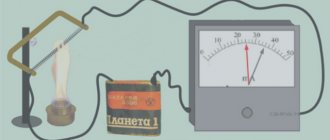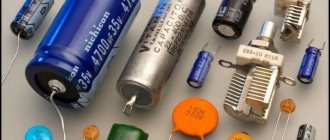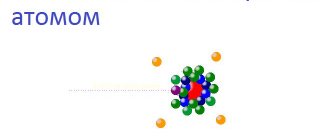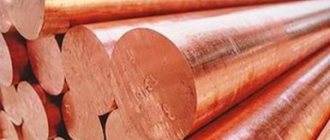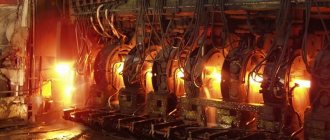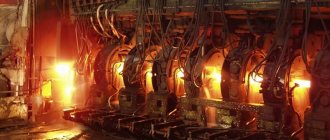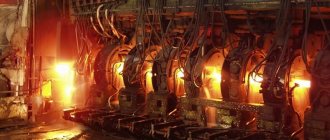Electrical conductivity of AISI stainless alloys
Electrical conductivity (electrical conductivity) and electrical resistance for stainless alloys
In this table you can see both the conductivity and resistance of stainless steels of the AISI grade and not only. Footnotes for terms at the bottom of the table.
| Material | Conductivity | Resistance | |
| Materials | Conductivity * (% IACS) | Conductivity * (Siemens/m) | Resistance * (Ohm*m) |
| Iron and cast iron | |||
| Pure iron | 18.00 | 1.044*10 7 | 9.579*10 -8 |
| In Iron Ingot ingot (not called ignot) (99.9% Fe) | 15.60 | 9.048*10 6 | 1.105*10 -7 |
| Low carbon white cast iron | 3.25 | 5.300*10 -7 | |
| Martensitic nickel-chromium iron | 2.16 | 8.000*10 -7 | |
| High-silicon cast iron | 3.45 | 5.000*10 -7 | |
| Iron-nickel alloys/ h igh-nickel iron | 1.0-1.2 | 1.4*10 -6 –1.7*10 -6 | |
| Chrome-nickel silicon iron / nickel-chromium-silicon iron | 1.0-1.2 | 1.5*10 -6 –1.7*10 -6 | |
| Aluminum-iron alloys / high-aluminum iron | 0.72 | 2.400*10 -6 | |
| Silicon cast iron/ medium-silicoon ductile iron | 2.0-3.0 | 5.8*10 -7 –8.7*10 -7 | |
| Niel-iron alloys / high-nickel ductile (20% Ni) | 1.69 | 1.020*10 -6 | |
| Carbon and low alloy steels. AISI | |||
| 1008 (Annealed) | 11.81 | 1.460*10 -7 | |
| 1010 | 12.06 | 1.430*10 -7 | |
| 1015 (Annealed) | 10.84 | 1.590*10 -7 | |
| 1016 (Annealed) | 10.78 | 1.600*10 -7 | |
| 1018 (Annealed) | 10.84 | 1.590*10 -7 | |
| 1020 | 10.84 | 1.590*10 -7 | |
| 1022 (Annealed) | 10.84 | 1.590*10 -7 | |
| 1025 (Annealed) | 10.84 | 1.590*10 -7 | |
| 1029 (Annealed) | 10.78 | 1.600*10 -7 | |
| 1030 (Annealed) | 10.39 | 1.660*10 -7 | |
| 1035 (Annealed) | 10.58 | 1.630*10 -7 | |
| 1040 (Annealed) | 10.78 | 1.600*10 -7 | |
| 1042 (Annealed) | 10.08 | 1.710*10 -7 | |
| 1043 (Annealed) | 10.58 | 1.630*10 -7 | |
| 1045 (Annealed) | 10.64 | 1.620*10 -7 | |
| 1046 | 10.58 | 1.630*10 -7 | |
| 1050 (annealed) | 10.58 | 1.630*10 -7 | |
| 1055 | 10.58 | 1.630*10 -7 | |
| 1060 | 9.58 | 1.800*10 -7 | |
| 1065 | 10.58 | 1.630*10 -7 | |
| 1070 | 10.26 | 1.680*10 -7 | |
| 1078 (Annealed) | 9.58 | 1.800*10 -7 | |
| 1080 | 9.58 | 1.800*10 -7 | |
| 1095 | 9.58 | 1.800*10 -7 | |
| 1137 | 10.14 | 1.700*10 -7 | |
| 1141 | 10.14 | 1.700*10 -7 | |
| 1151 | 10.14 | 1.700*10 -7 | |
| 1524 | 8.29 | 2.080*10 -7 | |
| 1524 (Annealed) | 10.78 | 1.600*10 -7 | |
| 1552 | 10.58 | 1.630*10 -7 | |
| 4130 (Quenched and tempered) | 7.73 | 2.230*10 -7 | |
| 4140 (Quenched and tempered) | 7.84 | 2.200*10 -7 | |
| 4626 (Normalized and released) | 8.62 | 2.000*10 -7 | |
| 4815 | 6.63 | 2.600*10 -7 | |
| 5132 | 8.21 | 2.100*10 -7 | |
| 5140 (Quenched and tempered) | 7.56 | 2.280*10 -7 | |
| Cold-worked AISI annealed stainless steels | |||
| 201 | 2.50 | 6.900*10 -7 | |
| 202 | 2.50 | 6.900*10 -7 | |
| 301 | 2.39 | 7.200*10 -7 | |
| 302 | 2.39 | 7.200*10 -7 | |
| 302B | 2.39 | 7.200*10 -7 | |
| 303 | 2.39 | 7.200*10 -7 | |
| 304 | 2.39 | 7.200*10 -7 | |
| 302Cu | 2.39 | 7.200*10 -7 | |
| 304N | 2.39 | 7.200*10 -7 | |
| 304 | 2.50 | 1.450*10 6 | 6.897*10 -7 |
| 304 | 2.50 | 1.450*10 6 | 6.897*10 -7 |
| 305 | 2.39 | 7.200*10 -7 | |
| 308 | 2.39 | 7.200*10 -7 | |
| 309 | 2.21 | 7.800*10 -7 | |
| 310 | 2.21 | 7.800*10 -7 | |
| 314 | 2.24 | 7.700*10 -7 | |
| 316 | 2.33 | 7.400*10 -7 | |
| 316N | 2.33 | 7.400*10 -7 | |
| 316 | 2.30 | 1.334*10 6 | 7.496*10 -7 |
| 317 | 2.33 | 7.400*10 -7 | |
| 317L | 2.18 | 7.900*10 -7 | |
| 321 | 2.39 | 7.200*10 -7 | |
| 329 | 2.30 | 7.500*10 -7 | |
| 330 | 1.69 | 1.020*10 -6 | |
| 347 | 2.36 | 7.300*10 -7 | |
| 347 | 2.40 | 1.392*10 6 | 7.184*10 -7 |
| 384 | 2.18 | 7.900*10 -7 | |
| 405 | 2.87 | 6.000*10 -7 | |
| 410 | 3.02 | 5.700*10 -7 | |
| 414 | 2.46 | 7.000*10 -7 | |
| 416 | 3.02 | 5.700*10 -7 | |
| 420 | 3.13 | 5.500*10 -7 | |
| 429 | 2.92 | 5.900*10 -7 | |
| 430 | 2.87 | 6.000*10 -7 | |
| 430F | 2.87 | 6.000*10 -7 | |
| 431 | 2.39 | 7.200*10 -7 | |
| 434 | 2.87 | 6.000*10 -7 | |
| 436 | 2.87 | 6.000*10 -7 | |
| 439 | 2.74 | 6.300*10 -7 | |
| 440A | 2.87 | 6.000*10 -7 | |
| 440C | 2.87 | 6.000*10 -7 | |
| 444 | 2.78 | 6.200*10 -7 | |
| 446 | 2.57 | 6.700*10 -7 | |
| PH 13-8 Mo | 1.69 | 1.020*10 -6 | |
| 15-5 PH | 2.24 | 7.700*10 -7 | |
| 17-4 PH | 2.16 | 8.000*10 -7 | |
| 17-7 PH | 2.08 | 8.300*10 -7 | |
| Cold-worked and sintered superalloys (superalloys, superaloys) | |||
| Elgiloy | 1.73 | 9.950*10 -7 | |
| Hastelloy Hastelloy “A” | 1.40 | 8.120*10 5 | 1.232*10 -6 |
| Hastelloy Hastelloy “B” and “C” | 1.30 | 7.540*10 5 | 1.326*10 -6 |
| Hastelloy Hastelloy”D” | 1.50 | 8.700*10 5 | 1.149*10 -6 |
| Hastelloy Hastelloy”X” | 1.50 | 8.700*10 5 | 1.149*10 -6 |
| Haynes 150 | 2.13 | 8.100*10 -7 | |
| Haynes 188 | 1.87 | 9.220*10 -7 | |
| Haynes 230 | 1.38 | 1.250*10 -6 | |
| Incoloy 800 Incoloy | 1.74 | 9.890*10 -7 | |
| Incoloy 825 | 1.53 | 1.130*10 -6 | |
| Incoloy 903 | 2.83 | 6.100*10 -7 | |
| Incoloy 907 | 2.47 | 6.970*10 -7 | |
| Incoloy 909 | 2.37 | 7.280*10 -7 | |
| Inconel 600 Inconel | 1.70 | 9.860*10 5 | 1.014*10 -6 |
| Inconel 600 | 1.67 | 1.030*10 -6 | |
| Inconel 601 | 1.45 | 1.190*10 -6 | |
| Inconel 617 | 1.41 | 1.220*10 -6 | |
| Inconel 625 | 1.34 | 1.290*10 -6 | |
| Inconel 690 | 11.65 | 1.480*10 -7 | |
| Inconel 718 | 1.38 | 1.250*10 -6 | |
| Inconel X750 | 1.41 | 1.220*10 -6 | |
| L-605 | 1.94 | 8.900*10 -7 | |
| M-252 | 1.58 | 1.090*10 -6 | |
| MP35N | 1.71 | 1.010*10 -6 | |
| Nimonic? 263 | 1.50 | 1.150*10 -6 | |
| Nimonic 105 | 1.32 | 1.310*10 -6 | |
| Nimonic 115 | 1.24 | 1.390*10 -6 | |
| Nimonic 75 | 1.39 | 1.240*10 -6 | |
| Nimonic 80A | 1.36 | 1.270*10 -6 | |
| Nimonic 90 | 1.46 | 1.180*10 -6 | |
| Nimonic PE.16 | 1.57 | 1.100*10 -6 | |
| Nimonic PK.33 | 1.37 | 1.260*10 -6 | |
| Rene 41 | 1.32 | 1.308*10 -6 | |
| Stellite 6B Stellite, stellite | 1.89 | 9.100*10 -7 | |
| Udimet 500 | 1.43 | 1.203*10 -6 | |
| Waspaloy | 1.39 | 1.240*10 -6 | |
Electrical conductivity (siemens/m) Siemens is a unit of measurement of electrical conductivity in the SI system, the reciprocal of the ohm. In other words, conductivity in siemens is simply one divided by resistance in ohms. cm = 1 / Ohm = A / B = kg-1 m-2 s³A²
Resistance (Ohm*m) The physical meaning of resistivity: a material has a resistivity of one Ohm cm if a cube made from this material with a side of 1 centimeter has a resistance of 1 Ohm when measured on opposite faces of the cube. In technology, the unit Ohm mm²/m is more often used. The resistivity of a homogeneous piece of conductor 1 meter long and a current-carrying cross-sectional area of 1 mm² is equal to 1 Ohm mm²/m, if its resistance is 1 Ohm.
Source
Selecting wire for thermal control
back to top
Stainless steel wires are the clear winner among other thermal control materials. They are easy to use, hold their shape well and work in two modes (TC and VW).
Due to the nickel content of stainless steel, although very low, people with an allergic reaction to it should probably avoid using this material.
What should you do if you are allergic to nickel, but want to vape in temperature control mode? In this case, you should give preference to titanium. But you should always remember that it should not be overheated.
AISI 304
Designation according to international standards
| International standard | American ASTM A240 | European EN 10088-2 | Russian GOST 5632-72 |
| Brand designation | AISI 304 | 1.4301 | 08Х18Н10 |
| 12Х18Н9 |
Applicable standards and approvals
AMS 5513 ASTM A 240 ASTM A 666
Classification
corrosion-resistant, heat-resistant steel
Application
- Household items
- Sinks
- Frames for metal structures in the construction industry
- Kitchen utensils and catering equipment
- Dairy equipment, brewing
- Welded structures
- Tanks on ships and land tankers for food, beverages and some chemicals
Typically, steel manufacturers divide the grade into three main classes (grades) according to their drawing ability:
- AISI 304 - Main grade
- AISI 304 DDQ (Normal and deep drawing) - Deep drawing grade
- AISI 304 DDS (Extra deep drawing) - Extra deep drawing grade
Main characteristics
Chemical composition (% by weight)
| standard | brand | C | Si | Mn | P | S | Cr | Ni |
| ASTM A240 | AISI 304 | ≤0.080 | ≤0.75 | ≤2.0 | ≤0.045 | ≤0.030 | 18.00 — 20.00 | 8.00 — 10.50 |
Mechanical properties
| AISI 304 | Tensile strength (σв), N/mm² | Yield strength(σ0.2), N/mm² | Yield strength(σ1.0), N/mm² | Relative elongation (σ), % | Brinell Hardness (HB) | Rockwell Hardness (HRB) |
| According to EN 10088-2 | ≥520 | ≥210 | ≥250 | ≥45 | — | — |
| According to ASTM A 240 | ≥515 | ≥205 | — | ≥40 | 202 | 85 |
Mechanical properties at high temperatures
All these values refer only to AISI 304
.
Physical properties
| Physical properties | Legend | Unit | Temperature | Meaning |
| Density | d | — | 4°C | 7.93 |
| Melting temperature | °C | 1450 | ||
| Specific heat | c | J/kg.K | 20°C | 500 |
| Thermal expansion | k | W/mK | 20°C | 15 |
| Average coefficient of thermal expansion | α | 10 -6 .K -1 | 0-100°C 0-200°C | 17.5 18 |
| Electrical resistivity | ρ | Ωmm 2 /m | 20°C | 0.80 |
| Magnetic permeability | μ | at 0.80 kA/m DC or h/h AC | 20°C μ μ discharge air | 1.02 |
| Elastic modulus | E | MPa x 10 3 | 20°C | 200 |
Corrosion resistance
304 steels have good resistance to general corrosive environments, but are not recommended where there is a risk of intergranular corrosion. They are well suited for use in fresh water and urban and rural environments. In all cases, regular cleaning of external surfaces is necessary to maintain their original condition.
304 steels have good resistance to various acids:
- phosphoric acid in all concentrations at ambient temperature,
- nitric acid up to 65% at temperatures 20°C - 50°C,
- formic and lactic acid at room temperature,
- acetic acid at a temperature of 20°C - 50°C.
They are recommended for the production of equipment in contact with cold or hot food products: wine, beer, milk (fermented milk products), alcohol, natural fruit juices, syrups, molasses, etc.
Acidic environments
| Temperature, °C | 20 | 80 | ||||||||||
| Concentration, % by weight | 10 | 20 | 40 | 60 | 80 | 100 | 10 | 20 | 40 | 60 | 80 | 100 |
| Sulfuric acid | 2 | 2 | 2 | 2 | 1 | 2 | 2 | 2 | 2 | 2 | 2 | |
| Nitric acid | 2 | 1 | 2 | |||||||||
| Phosphoric acid | 2 | 1 | 2 | |||||||||
| Formic acid | 1 | 2 | 2 | 1 | ||||||||
Code: 0 = high degree of protection - Corrosion rate less than 100 µm/year 1 = partial protection - Corrosion rate from 100 to 1000 µm/year 2 = no protection - Corrosion rate more than 1000 µm/year
Atmospheric influences
Comparison of 304
grades with other metals in various environments (Corrosion rate calculated for 10-year exposure).
| Environment | Corrosion rate (μm/year) | ||
| AISI 304 | Aluminum-3S | Carbon steel | |
| Rural | 0.0025 | 0.025 | 5.8 |
| Marine | 0.0076 | 0.432 | 34.0 |
| Industrial Marine | 0.0076 | 0.686 | 46.2 |
Resistant to corrosion in boiling chemicals
| Boiling medium | Metal condition | Corrosion rate (mm/year) |
| 20% acetic acid | Regular metal Welded | * (With a sample thickness of 0.8 mm and a press diameter of 20 mm) |
| AISI 430 | 2.05 mm | |
| AISI 304 | 2.0 mm |
*Limiting drawing ratio - limiting drawing ratio
Electrical conductivity of AISI stainless alloys
Electrical conductivity (electrical conductivity) and electrical resistance for stainless alloys
In this table you can see both the conductivity and resistance of stainless steels of the AISI grade and not only. Footnotes for terms at the bottom of the table.
| Material | Conductivity | Resistance | |
| Materials | Conductivity * (% IACS) | Conductivity * (Siemens/m) | Resistance * (Ohm*m) |
| Iron and cast iron | |||
| Pure iron | 18.00 | 1.044*10 7 | 9.579*10 -8 |
| In Iron Ingot ingot (not called ignot) (99.9% Fe) | 15.60 | 9.048*10 6 | 1.105*10 -7 |
| Low carbon white cast iron | 3.25 | 5.300*10 -7 | |
| Martensitic nickel-chromium iron | 2.16 | 8.000*10 -7 | |
| High-silicon cast iron | 3.45 | 5.000*10 -7 | |
| Iron-nickel alloys/ h igh-nickel iron | 1.0-1.2 | 1.4*10 -6 –1.7*10 -6 | |
| Chrome-nickel silicon iron / nickel-chromium-silicon iron | 1.0-1.2 | 1.5*10 -6 –1.7*10 -6 | |
| Aluminum-iron alloys / high-aluminum iron | 0.72 | 2.400*10 -6 | |
| Silicon cast iron/ medium-silicoon ductile iron | 2.0-3.0 | 5.8*10 -7 –8.7*10 -7 | |
| Niel-iron alloys / high-nickel ductile (20% Ni) | 1.69 | 1.020*10 -6 | |
| Carbon and low alloy steels. AISI | |||
| 1008 (Annealed) | 11.81 | 1.460*10 -7 | |
| 1010 | 12.06 | 1.430*10 -7 | |
| 1015 (Annealed) | 10.84 | 1.590*10 -7 | |
| 1016 (Annealed) | 10.78 | 1.600*10 -7 | |
| 1018 (Annealed) | 10.84 | 1.590*10 -7 | |
| 1020 | 10.84 | 1.590*10 -7 | |
| 1022 (Annealed) | 10.84 | 1.590*10 -7 | |
| 1025 (Annealed) | 10.84 | 1.590*10 -7 | |
| 1029 (Annealed) | 10.78 | 1.600*10 -7 | |
| 1030 (Annealed) | 10.39 | 1.660*10 -7 | |
| 1035 (Annealed) | 10.58 | 1.630*10 -7 | |
| 1040 (Annealed) | 10.78 | 1.600*10 -7 | |
| 1042 (Annealed) | 10.08 | 1.710*10 -7 | |
| 1043 (Annealed) | 10.58 | 1.630*10 -7 | |
| 1045 (Annealed) | 10.64 | 1.620*10 -7 | |
| 1046 | 10.58 | 1.630*10 -7 | |
| 1050 (annealed) | 10.58 | 1.630*10 -7 | |
| 1055 | 10.58 | 1.630*10 -7 | |
| 1060 | 9.58 | 1.800*10 -7 | |
| 1065 | 10.58 | 1.630*10 -7 | |
| 1070 | 10.26 | 1.680*10 -7 | |
| 1078 (Annealed) | 9.58 | 1.800*10 -7 | |
| 1080 | 9.58 | 1.800*10 -7 | |
| 1095 | 9.58 | 1.800*10 -7 | |
| 1137 | 10.14 | 1.700*10 -7 | |
| 1141 | 10.14 | 1.700*10 -7 | |
| 1151 | 10.14 | 1.700*10 -7 | |
| 1524 | 8.29 | 2.080*10 -7 | |
| 1524 (Annealed) | 10.78 | 1.600*10 -7 | |
| 1552 | 10.58 | 1.630*10 -7 | |
| 4130 (Quenched and tempered) | 7.73 | 2.230*10 -7 | |
| 4140 (Quenched and tempered) | 7.84 | 2.200*10 -7 | |
| 4626 (Normalized and released) | 8.62 | 2.000*10 -7 | |
| 4815 | 6.63 | 2.600*10 -7 | |
| 5132 | 8.21 | 2.100*10 -7 | |
| 5140 (Quenched and tempered) | 7.56 | 2.280*10 -7 | |
| Cold-worked AISI annealed stainless steels | |||
| 201 | 2.50 | 6.900*10 -7 | |
| 202 | 2.50 | 6.900*10 -7 | |
| 301 | 2.39 | 7.200*10 -7 | |
| 302 | 2.39 | 7.200*10 -7 | |
| 302B | 2.39 | 7.200*10 -7 | |
| 303 | 2.39 | 7.200*10 -7 | |
| 304 | 2.39 | 7.200*10 -7 | |
| 302Cu | 2.39 | 7.200*10 -7 | |
| 304N | 2.39 | 7.200*10 -7 | |
| 304 | 2.50 | 1.450*10 6 | 6.897*10 -7 |
| 304 | 2.50 | 1.450*10 6 | 6.897*10 -7 |
| 305 | 2.39 | 7.200*10 -7 | |
| 308 | 2.39 | 7.200*10 -7 | |
| 309 | 2.21 | 7.800*10 -7 | |
| 310 | 2.21 | 7.800*10 -7 | |
| 314 | 2.24 | 7.700*10 -7 | |
| 316 | 2.33 | 7.400*10 -7 | |
| 316N | 2.33 | 7.400*10 -7 | |
| 316 | 2.30 | 1.334*10 6 | 7.496*10 -7 |
| 317 | 2.33 | 7.400*10 -7 | |
| 317L | 2.18 | 7.900*10 -7 | |
| 321 | 2.39 | 7.200*10 -7 | |
| 329 | 2.30 | 7.500*10 -7 | |
| 330 | 1.69 | 1.020*10 -6 | |
| 347 | 2.36 | 7.300*10 -7 | |
| 347 | 2.40 | 1.392*10 6 | 7.184*10 -7 |
| 384 | 2.18 | 7.900*10 -7 | |
| 405 | 2.87 | 6.000*10 -7 | |
| 410 | 3.02 | 5.700*10 -7 | |
| 414 | 2.46 | 7.000*10 -7 | |
| 416 | 3.02 | 5.700*10 -7 | |
| 420 | 3.13 | 5.500*10 -7 | |
| 429 | 2.92 | 5.900*10 -7 | |
| 430 | 2.87 | 6.000*10 -7 | |
| 430F | 2.87 | 6.000*10 -7 | |
| 431 | 2.39 | 7.200*10 -7 | |
| 434 | 2.87 | 6.000*10 -7 | |
| 436 | 2.87 | 6.000*10 -7 | |
| 439 | 2.74 | 6.300*10 -7 | |
| 440A | 2.87 | 6.000*10 -7 | |
| 440C | 2.87 | 6.000*10 -7 | |
| 444 | 2.78 | 6.200*10 -7 | |
| 446 | 2.57 | 6.700*10 -7 | |
| PH 13-8 Mo | 1.69 | 1.020*10 -6 | |
| 15-5 PH | 2.24 | 7.700*10 -7 | |
| 17-4 PH | 2.16 | 8.000*10 -7 | |
| 17-7 PH | 2.08 | 8.300*10 -7 | |
| Cold-worked and sintered superalloys (superalloys, superaloys) | |||
| Elgiloy | 1.73 | 9.950*10 -7 | |
| Hastelloy Hastelloy “A” | 1.40 | 8.120*10 5 | 1.232*10 -6 |
| Hastelloy Hastelloy “B” and “C” | 1.30 | 7.540*10 5 | 1.326*10 -6 |
| Hastelloy Hastelloy”D” | 1.50 | 8.700*10 5 | 1.149*10 -6 |
| Hastelloy Hastelloy”X” | 1.50 | 8.700*10 5 | 1.149*10 -6 |
| Haynes 150 | 2.13 | 8.100*10 -7 | |
| Haynes 188 | 1.87 | 9.220*10 -7 | |
| Haynes 230 | 1.38 | 1.250*10 -6 | |
| Incoloy 800 Incoloy | 1.74 | 9.890*10 -7 | |
| Incoloy 825 | 1.53 | 1.130*10 -6 | |
| Incoloy 903 | 2.83 | 6.100*10 -7 | |
| Incoloy 907 | 2.47 | 6.970*10 -7 | |
| Incoloy 909 | 2.37 | 7.280*10 -7 | |
| Inconel 600 Inconel | 1.70 | 9.860*10 5 | 1.014*10 -6 |
| Inconel 600 | 1.67 | 1.030*10 -6 | |
| Inconel 601 | 1.45 | 1.190*10 -6 | |
| Inconel 617 | 1.41 | 1.220*10 -6 | |
| Inconel 625 | 1.34 | 1.290*10 -6 | |
| Inconel 690 | 11.65 | 1.480*10 -7 | |
| Inconel 718 | 1.38 | 1.250*10 -6 | |
| Inconel X750 | 1.41 | 1.220*10 -6 | |
| L-605 | 1.94 | 8.900*10 -7 | |
| M-252 | 1.58 | 1.090*10 -6 | |
| MP35N | 1.71 | 1.010*10 -6 | |
| Nimonic? 263 | 1.50 | 1.150*10 -6 | |
| Nimonic 105 | 1.32 | 1.310*10 -6 | |
| Nimonic 115 | 1.24 | 1.390*10 -6 | |
| Nimonic 75 | 1.39 | 1.240*10 -6 | |
| Nimonic 80A | 1.36 | 1.270*10 -6 | |
| Nimonic 90 | 1.46 | 1.180*10 -6 | |
| Nimonic PE.16 | 1.57 | 1.100*10 -6 | |
| Nimonic PK.33 | 1.37 | 1.260*10 -6 | |
| Rene 41 | 1.32 | 1.308*10 -6 | |
| Stellite 6B Stellite, stellite | 1.89 | 9.100*10 -7 | |
| Udimet 500 | 1.43 | 1.203*10 -6 | |
| Waspaloy | 1.39 | 1.240*10 -6 |
Electrical conductivity (siemens/m) Siemens is a unit of measurement of electrical conductivity in the SI system, the reciprocal of the ohm. In other words, conductivity in siemens is simply one divided by resistance in ohms. cm = 1 / Ohm = A / B = kg-1 m-2 s³A²
Resistance (Ohm*m) The physical meaning of resistivity: a material has a resistivity of one Ohm cm if a cube made from this material with a side of 1 centimeter has a resistance of 1 Ohm when measured on opposite faces of the cube. In technology, the unit Ohm mm²/m is more often used. The resistivity of a homogeneous piece of conductor 1 meter long and a current-carrying cross-sectional area of 1 mm² is equal to 1 Ohm mm²/m, if its resistance is 1 Ohm.
Electrical resistivity of steel at different temperatures
Tables of electrical resistivity values of steels of various types and grades are presented depending on temperature - in the range from 0 to 1350°C.
In general, resistivity is determined only by the composition of the substance and its temperature; it is numerically equal to the total resistance of an isotropic conductor having a length of 1 m and a cross-sectional area of 1 m 2.
The electrical resistivity of steel depends significantly on composition and temperature. As the temperature of this metal increases, the frequency and amplitude of vibrations of the atoms of the crystal lattice increases, which creates additional resistance to the passage of electric current through the thickness of the alloy. Therefore, with increasing temperature, the resistance of steel increases.
Changing the composition of steel and the percentage of alloying additives in it significantly affects the value of electrical resistance. For example, carbon and low-alloy steels conduct electric current several times better than high-alloy and heat-resistant steels, which have a high nickel and chromium content.
Titanium
up
Titanium wire is pure titanium and is designed for temperature control applications.
There is some controversy surrounding the safety of titanium wire when used in vaping.
When heated above 648 °C (1200 °F), titanium can release the toxic compound titanium dioxide. Additionally, once titanium catches fire, it is extremely difficult to extinguish.
For this reason, some shops do not carry titanium wire to avoid liability and safety issues.
Nevertheless, some vapers use this material. If the temperature control mode on the device is working properly, then there is no reason to worry about titanium dioxide poisoning or fire.
Manufacturers of vape devices have already thought about this. But you definitely shouldn’t burn through titanium spirals!
Titanium is easy to work with when making and winding spirals; it holds its shape well. But if the spiral is deformed, it is quite difficult to correct it.
- Operation in temperature control mode;
- Easy to use;
- Holds its shape well;
- May be toxic;
- Fire hazard;
- Low availability in stores.
Carbon steels
Carbon steels at room temperature, as already mentioned, have low electrical resistivity due to their high iron content. At 20°C, the value of their resistivity is in the range from 13·10 -8 (for steel 08KP) to 20·10 -8 Ohm m (for U12).
When heated to temperatures above 1000°C, the ability of carbon steels to conduct electric current is greatly reduced. The resistance value increases by an order of magnitude and can reach a value of 130·10 -8 Ohm·m.
Electrical resistivity of carbon steels ρe·10 8 , Ohm m
| Temperature, °C | Steel 08KP | Steel 08 | Steel 20 | Steel 40 | Steel U8 | Steel U12 |
| 12 | 13,2 | 15,9 | 16 | 17 | 18,4 | |
| 20 | 13 | 14,2 | 16,9 | 17,1 | 18 | 19,6 |
| 50 | 14,7 | 15,9 | 18,7 | 18,9 | 19,8 | 21,6 |
| 100 | 17,8 | 19 | 21,9 | 22,1 | 23,2 | 25,2 |
| 150 | 21,3 | 22,4 | 25,4 | 25,7 | 26,8 | 29 |
| 200 | 25,2 | 26,3 | 29,2 | 29,6 | 30,8 | 33,3 |
| 250 | 29,5 | 30,5 | 33,4 | 33,9 | 35,1 | 37,9 |
| 300 | 34,1 | 35,2 | 38,1 | 38,7 | 39,8 | 43 |
| 350 | 39,3 | 40,2 | 43,2 | 43,8 | 45 | 48,3 |
| 400 | 44,8 | 45,8 | 48,7 | 49,3 | 50,5 | 54 |
| 450 | 50,9 | 51,8 | 54,6 | 55,3 | 56,5 | 60 |
| 500 | 57,5 | 58,4 | 60,1 | 61,9 | 62,8 | 66,5 |
| 550 | 64,8 | 65,7 | 68,2 | 68,9 | 69,9 | 73,4 |
| 600 | 72,5 | 73,4 | 75,8 | 76,6 | 77,2 | 80,2 |
| 650 | 80,7 | 81,6 | 83,7 | 84,4 | 85,2 | 87,8 |
| 700 | 89,8 | 90,5 | 92,5 | 93,2 | 93,5 | 96,4 |
| 750 | 100,3 | 101,1 | 105 | 107,9 | 110,5 | 113 |
| 800 | 107,3 | 108,1 | 109,4 | 111,1 | 112,9 | 115 |
| 850 | 110,4 | 111,1 | 111,8 | 113,1 | 114,8 | 117,6 |
| 900 | 112,4 | 113 | 113,6 | 114,9 | 116,4 | 119,6 |
| 950 | 114,2 | 114,8 | 115,2 | 116,6 | 117,8 | 121,2 |
| 1000 | 116 | 116,5 | 116,7 | 117,9 | 119,1 | 122,6 |
| 1050 | 117,5 | 117,9 | 118,1 | 119,3 | 120,4 | 123,8 |
| 1100 | 118,9 | 119,3 | 119,4 | 120,7 | 121,4 | 124,9 |
| 1150 | 120,3 | 120,7 | 120,7 | 122 | 122,3 | 126 |
| 1200 | 121,7 | 122 | 121,9 | 123 | 123,1 | 127,1 |
| 1250 | 123 | 123,3 | 122,9 | 124 | 123,8 | 128,2 |
| 1300 | 124,1 | 124,4 | 123,9 | — | 124,6 | 128,7 |
| 1350 | 125,2 | 125,3 | 125,1 | — | 125 | 129,5 |
Conclusion
back to top
line is that the choice of coil material is an important variable when looking for “zen” in vaping. In fact, finding “your” material affects the positive vaping experience.
The thickness of the wire and the number of turns only affects the heating speed, current, power and resistance. By changing the number of turns, the diameter of the spiral and the thickness of the wire, you can get a completely new experience.
Ultimately, it is the positive vaping experience that makes vaping enjoyable.
Low alloy steels
Low alloy steels are able to resist the passage of electricity slightly more than carbon steels. Their electrical resistivity is (20...43)·10 -8 Ohm·m at room temperature.
It should be noted that steel grades of this type are the worst conductors of electric current - these are 18Х2Н4ВА and 50С2Г. However, at high temperatures, the ability to conduct electric current among the steels listed in the table practically does not differ.
Electrical resistivity of low-alloy steels ρe·10 8 , Ohm m
| steel grade | 20 | 100 | 300 | 500 | 700 | 900 | 1100 | 1300 |
| 15HF | — | 28,1 | 42,1 | 60,6 | 83,3 | — | — | — |
| 30X | 21 | 25,9 | 41,7 | 63,6 | 93,4 | 114,5 | 120,5 | 125,1 |
| 12ХН2 | 33 | 36 | 52 | 67 | — | 112 | — | — |
| 12ХН3 | 29,6 | — | — | 67 | — | 116 | — | — |
| 20ХН3 | 24 | 29 | 46 | 66 | — | 123 | — | — |
| 30ХН3 | 26,8 | 31,7 | 46,9 | 68,1 | 98,1 | 114,8 | 120,1 | 124,6 |
| 20ХН4Ф | 36 | 41 | 56 | 72 | 102 | 118 | — | — |
| 18Х2Н4ВА | 41 | 44 | 58 | 73 | 97 | 115 | — | — |
| 30G2 | 20,8 | 25,9 | 42,1 | 64,5 | 94,6 | 114,3 | 120,2 | 125 |
| 12MH | 24,6 | 27,4 | 40,6 | 59,8 | — | — | — | — |
| 40Х3М | — | 33,1 | 48,2 | 69,5 | 96,2 | — | — | — |
| 20Х3ФВМ | — | 39,8 | 54,4 | 74,3 | 98,2 | — | — | — |
| 50S2G | 42,9 | 47 | 60,1 | 78,8 | 105,7 | 119,7 | 124,9 | 128,9 |
| 30N3 | 27,1 | 32 | 47 | 67,9 | 99,2 | 114,9 | 120,4 | 124,8 |
High alloy steels
High-alloy steels have electrical resistivity several times higher than carbon and low-alloy steels. According to the table, it can be seen that at a temperature of 20°C its value is (30...86)·10 -8 Ohm·m.
At a temperature of 1300°C, the resistance of high- and low-alloy steels becomes almost the same and does not exceed 131·10 -8 Ohm·m.
Electrical resistivity of high-alloy steels ρe·10 8 , Ohm m
| steel grade | 20 | 100 | 300 | 500 | 700 | 900 | 1100 | 1300 |
| G13 | 68,3 | 75,6 | 93,1 | 95,2 | 114,7 | 123,8 | 127 | 130,8 |
| G20H12F | 72,3 | 79,2 | 91,2 | 101,5 | 109,2 | — | — | — |
| G21X15T | — | 82,4 | 95,6 | 104,5 | 112 | 119,2 | — | — |
| Х13Н13К10 | — | 90 | 100,8 | 109,6 | 115,4 | 119,6 | — | — |
| Х19Н10К47 | — | 90,5 | 98,6 | 105,2 | 110,8 | — | — | — |
| P18 | 41,9 | 47,2 | 62,7 | 81,5 | 103,7 | 117,3 | 123,6 | 128,1 |
| EH12 | 31 | 36 | 53 | 75 | 97 | 119 | — | — |
| 40Х10С2М (EI107) | 86 | 91 | 101 | 112 | 122 | — | — | — |
Introduction
top
The purpose of this article is to introduce some of the most common materials for winding spirals, their purpose and characteristics.
Some materials are only suitable for wattage mode, others are only suitable for temperature control and one material is suitable for both modes.
The technical information provided in the article is intended for vapers of intermediate level and above, it allows you to decide on the selection of coil material and makes it easier to configure the devices.
The focus will be on single strand wires for vaping.
Tungsten and NiFe wires can also be used in vaping, but they are quite “capricious” to use and do not have any special advantages compared to more common materials.
Chromium stainless steels
Chromium stainless steels have a high concentration of chromium atoms, which increases their resistivity - the electrical conductivity of such stainless steel is not high. At normal temperatures, its resistance is (50...60)·10 -8 Ohm·m.
Electrical resistivity of chromium stainless steels ρe·10 8 , Ohm m
| steel grade | 20 | 100 | 300 | 500 | 700 | 900 | 1100 | 1300 |
| X13 | 50,6 | 58,4 | 76,9 | 93,8 | 110,3 | 115 | 119 | 125,3 |
| 2Х13 | 58,8 | 65,3 | 80 | 95,2 | 110,2 | — | — | — |
| 3Х13 | 52,2 | 59,5 | 76,9 | 93,5 | 109,9 | 114,6 | 120,9 | 125 |
| 4Х13 | 59,1 | 64,6 | 78,8 | 94 | 108 | — | — | — |
Chromium-nickel austenitic steels
Chromium-nickel austenitic steels are also stainless, but due to the addition of nickel they have a resistivity almost one and a half times higher than that of chromium steels - it reaches a value of (70...90)·10 -8 Ohm·m.
Electrical resistivity of chromium-nickel stainless steels ρe·10 8 , Ohm m
| steel grade | 20 | 100 | 300 | 500 | 700 | 900 | 1100 |
| 12Х18Н9 | — | 74,3 | 89,1 | 100,1 | 109,4 | 114 | — |
| 12Х18Н9Т | 72,3 | 79,2 | 91,2 | 101,5 | 109,2 | — | — |
| 17Х18Н9 | 72 | 73,5 | 92,5 | 103 | 111,5 | 118,5 | — |
| Х18Н11Б | — | 84,6 | 97,6 | 107,8 | 115 | — | — |
| Х18Н9В | 71 | 77,6 | 91,6 | 102,6 | 111,1 | 117,1 | 122 |
| 4Х14НВ2М (ЭИ69) | 81,5 | 87,5 | 100 | 110 | 117,5 | — | — |
| 1Х14Н14В2М (ЭИ257) | — | 82,4 | 95,6 | 104,5 | 112 | 119,2 | — |
| 1x14N18M3T | — | 89 | 100 | 107,5 | 115 | — | — |
| 36Х18Н25С2 (ЭЯ3С) | — | 98,5 | 105,5 | 110 | 117,5 | — | — |
| Х13Н25М2В2 | — | 103 | 112,1 | 118,1 | 121 | — | — |
| Х7Н25 (ЭИ25) | — | — | 109 | 115 | 121 | 127 | — |
| Х2Н35 (ЭИ36) | 87,5 | 92,5 | 103 | 110 | 116 | 120,5 | — |
| H28 | 84,2 | 89,1 | 99,6 | 107,7 | 114,2 | 118,4 | 122,5 |
Heat-resistant and heat-resistant steels
In terms of their electrical conductive properties, heat-resistant and heat-resistant steels are close to chromium-nickel steels. The high content of chromium and nickel in these alloys does not allow them to conduct electric current, like ordinary carbon alloys with a high concentration of iron.
The significant electrical resistivity and high operating temperature of such steels make it possible to use them as working elements of electric heaters. In particular, steel 20Х23Н18 in its resistance and heat resistance in some cases can replace such a popular alloy for heaters as nichrome Х20Н80.
Nickel
up
Nickel wire, so-called Ni200 grade, is pure nickel. This material was the first to be used for temperature control mode and is also the first on the list of materials that cannot be used in variable watt mode.
Nickel has two main disadvantages. The first disadvantage is the softness of the material - it is difficult to use it when creating spirals, and after installation the spiral can easily become deformed.
The second drawback is the composition of the material. Some people may experience discomfort with pure nickel windings, and there are many people with nickel allergies or varying degrees of sensitivity.
Although other materials such as nichrome and stainless steel also contain nickel, it is not the main component in them.
Nickel wires are still popular among temperature control hobbyists and are relatively easy to find commercially.
- Operation in temperature control mode;
- Not very convenient to use;
- Doesn't hold its shape well;
- Nickel content.
Steel Specifications
Before considering the resistivity of steel in detail, you should familiarize yourself with its basic physical and mechanical properties. Due to its qualities, this material is widely used in the manufacturing sector and other areas of people’s lives and activities.
Steel is an alloy of iron and carbon, contained in an amount not exceeding 1.7%. In addition to carbon, steel contains a certain amount of impurities - silicon, manganese, sulfur and phosphorus. In terms of its qualities, it is much better than cast iron; it can easily be hardened, forged, rolled and other types of processing. All types of steels are characterized by high strength and ductility.
According to its purpose, steel is divided into structural, instrumental, and also with special physical properties. Each of them contains a different amount of carbon, thanks to which the material acquires certain specific qualities, for example, heat resistance, heat resistance, resistance to rust and corrosion.
A special place is occupied by electrical steels, produced in sheet format and used in the production of electrical products. To obtain this material, silicon is doped, which can improve its magnetic and electrical properties.
In order for electrical steel to acquire the necessary characteristics, certain requirements and conditions must be met. The material must be easily magnetized and remagnetized, that is, have high magnetic permeability. Such steels have good magnetic induction, and their magnetization reversal occurs with minimal losses.
The dimensions and weight of magnetic cores and windings, as well as the efficiency of transformers and their operating temperature depend on compliance with these requirements. The fulfillment of the conditions is influenced by many factors, including the resistivity of steel.
Kantal (fechral)
up
Kanthal wire is a ferritic iron-chromium-aluminum (FeCrAl) alloy with good oxidation resistance and is used in vari-watt mode.
This is a good material for creating your own coils for serviced tanks, drips and the like, especially for beginners.
Kanthal is easy to work with, stiff enough to hold its shape when wound, and is a very popular material for making single-strand coils.
Kanthal is an inexpensive and widely available material and is available in most vape shops and online stores.
- Operates in variable watt mode;
- Easy to use;
- Holds its shape well;
- Wide availability;
- Inexpensive;
- Not compatible with thermal control.
